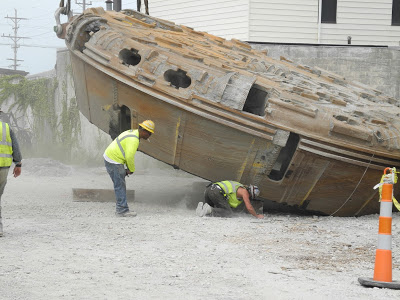
EVENT: One journey ends, another begins as Mackenzie will make her way back to the surface
Posted by Jared Shepherd
- 4287 Views
- September 6th, 2013
- in Miscellaneous
- No Comments
Mac’s on her way back to the surface starting Monday.
More than one year ago, the Northeast Ohio Regional Sewer District’s tunnel boring machine, named “Mackenzie,” began excavating the Euclid Creek Tunnel. Mackenzie has successfully mined and lined 18,000 feet of 24-foot diameter tunnel 200 feet below ground, and her work is complete ahead of schedule and under budget.
On Monday, September 9, Mackenzie’s 150-ton, 27-foot diameter cutter head will be lifted out of the exit shaft near the intersection of Nottingham Road and St. Clair Avenue. Later that day, the cutter head will return to the main construction site in Bratenahl.
UPDATE: Watch the video of Mac’s cutter head returning to the surface in the clip above.
You can #TrackMac‘s progress Monday by following our @neorsd and @WallyWaterdrop Twitter accounts for live #TrackMac tweets from the site.
The Euclid Creek Tunnel is the first in a series of storage tunnels constructed as a part of Project Clean Lake, the Sewer District’s 25-year, $3 billion program to drastically reduce the amount of combined sewage entering local waterways annually.
About the Euclid Creek Tunnel
The Euclid Creek Tunnel starts in Bratenahl, south of Interstate 90, and continues northeast to the District’s Easterly Wastewater Treatment Plant. There, the tunnel continues under Lake Erie for about 3,000 feet and passes under the shoreline near Green Creek at East 152nd Street. The tunnel then heads east, following Lake Shore Boulevard and Nottingham Road, and ends at St. Clair Avenue.
The Euclid Creek Tunnel is located 190 to 220 feet below ground. It is 18,000 feet long, with a finished diameter of 24 feet and will have the capacity to hold 60.5 million gallons of combined stormwater and wastewater. The estimated cost of construction for the Euclid Creek Tunnel is $198 million.
About Mackenzie our Tunnel Boring Machine
Mackenzie’s measurements and statistics are available in our Meet Mackenzie blog post.
- VIDEO: Watch Mackenzie’s cutter head as she prepared to begin her journey in May 2012
- PHOTOSET: See progress photos of the Euclid Creek Tunnel on our Facebook page
- IMAGES: You can download images of the break through here, here, and here. (All images courtesy Northeast Ohio Regional Sewer District)
- STATS: Meet Mackenzie: Learn more about the tunnel boring machine
 |
| After the cutter head was raised out of the shaft, it was lowered onto blocks until it could be loaded onto a trailer for transport. |
About Combined Sewer Overflows (CSOs)
Greater Cleveland’s earliest sewers (primarily within the City and its inner-ring suburbs) are combined sewers. Built around the turn of the 19th century, these sewers carry sewage, industrial waste, and stormwater in a single pipe.
During heavy rains, there is a dramatic increase of water flowing through the combined sewers. When this happens, control devices may allow some of the combined wastewater and stormwater to overflow into area waterways—such as Lake Erie and Euclid Creek—to prevent urban flooding. This event is called a combined sewer overflow, or CSO, and harms our clean water environment.
- VIDEO: How do combined sewers work?


